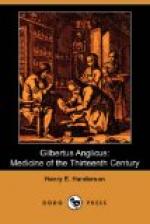Morbilli is a mild disease, but requires protection from cold, which confines and coagulates the peccant matter.
Attention is directed to the not infrequent ulcers of the eyes, which occur in variolae and may destroy the sight; also to ulcerations of the nose, throat, oesophagus, lungs and intestines, the latter of which often produce a dangerous diarrhoea.
When variolae occurs in boys, it is recommended to tie the hands of the patient to prevent scratching.
Whey is said to be an excellent drink for developing the eruption of variolae, and the time-honored saffron (crocus) appears in several of Gilbert’s prescriptions for this disease. Here, too, we find the earliest mention of the use of red colors in the treatment of variolae (f. 348 c):
“Vetule provinciales dant purpuram combustam in potu, habet enim occultam naturam curandi variolas. Similiter pannus tinctus de grano.”
Acid and saline articles of food should be avoided, sweets used freely, and the patients should be carefully guarded from cold.
Not the least interesting pages of the Compendium are those (there are about twenty of them) devoted to the discussion of poisons, poisoned wounds and hydrophobia.
An introductory chapter on the general subject of the character of poisonous matters, illustrated by some gruesome and Munchausen-like tales, borrowed mainly from Avicenna and Ruffus, on the wonders of acquired immunity to poisons, the horrors of the basilisk, the armaria (_?_), the deaf adder (aspis surda) and the red-hot regulus of Nubia, leads naturally to the consideration of some special poisons derived from the three kingdoms of nature. Very characteristically Gilbert displays his caution in the discussion of a dangerous subject by the following preface:
Abstineamus a venesis occultis quae non sunt manifesta, ne virus in angues adjiciamus, aut doctrinam perniciosam tradere videamur (f. 351 a).
Beginning then with metallic mercury (argentum vivum), he considers the poisonous effects of various salts of lead and copper, the vegetable poisons hellebore, anacardium (anacardis?), castoreum, opium and cassilago (semina hyoscyami), and then proceeds to the bites or rabid men and animals, hydrophobia, and the bites of scorpions, serpents and the animalia annulosa, that is, worms, wasps, bees, ants and spiders.
Space does not permit a careful review of this interesting subject, but a novel form of poisoning by the use of quicksilver is startling enough to claim our attention. Gilbert tells us that pouring metallic mercury into the ear produces the most distressing symptoms, severe pain, delirium, convulsions, epilepsy, apoplexy and, if the metal penetrates to the brain, ultimate death. In the treatment of this condition certain physicians had recommended the insertion into the ear of a thin




